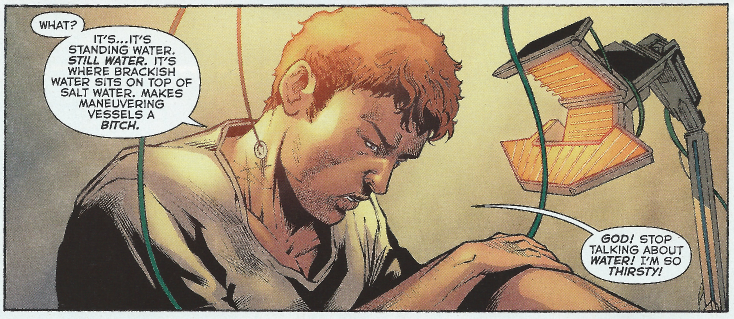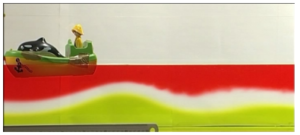Update: legendary oceanographer Dr. Kim Martini stops by to set the record straight on the challenging subject of internal waves. Her comments in bold.
It has been a long time since I’ve made an entry into our long-running, world-famous, Science of Aquaman series. The last few runs have been heavy on high adventure, but light on ocean tidbits for me to nerd out on. I don’t like to force ocean fact into comic fiction unless the opportunity presents itself.
So, with the newest run of Aquaman, starting with issue #50, focusing around a villain named Dead Water, I thought it was the perfect moment to talk about some physical oceanography. And then…

My hat’s off to Dan Abnett, who beat me to the science punchline. If I had to explain the phenomenon of dead water in a single tweet, it would have been pretty close to this. Well played, sir. Well played.
So what is dead water and why does it make maneuvering a vessel so challenging?
Dead water occurs when a lens of less dense low-salinity water sits on top of more dense salt water. This can happen anywhere where two water bodies converge, but most dramatically forms where glaciers melt into the sea. KM: You also tend to get dead water where there is a shallow freshwater river plume.

When a vessel moves across dead water, it creates a wave, but not necessarily on the water’s surface. Rather, the wave grows underneath, at the boundary between these two water masses. As the ship creates a wake, deeper water is drawn up to fill the gap forming an interfacial wave. KM: The hull of the boat perturbs the density interface. Buoyancy becomes the restoring force, pushing it back and then causing it to oscillate (similar to a sprint) and causing the wavelike undulations at the density interface. There is no gap because the water above and below the interface move horizontally to conserve mass. This image is an illustration of that. The thermocline is the density interface and the loops are currents.
The cool thing about dead water is that it happens regardless of how the ship propels itself–sailboats can be halted as effectively as powerboats–because it’s the physical presence of a moving boat that creates the effect. The further a ship travels across dead water, the larger the amplitude of the interfacial wave. KM: The amplitude depends on the ship size, speed and keel depth. It may also depend somewhat on the density difference between the upper and lower layers and their relative thicknesses. The speed of the interfacial wave only depends on the densities of the two layers and their thicknesses. There’s relatively simple equation for that assuming it’s a two-layer fluid. As the wave increases in amplitude, it also increases in speed, eventually overtaking the vessel. The wave doesn’t increase in speed unless the density of the layers or their thicknesses change. The wave catches up to the boat and breaks underneath it.
KM: The wave breaking underneath the boat increases drag and causes it to slow down. There is also drag on the boat as it originally creates the wave. The ship essentially falls backwards into the trough of this wave, which drags it to a halt (or at least significantly slows it down). For a sailor watching from the deck, it would seem as though the water itself were sucking the ship back.
Here is a video demonstrating this phenomenon: